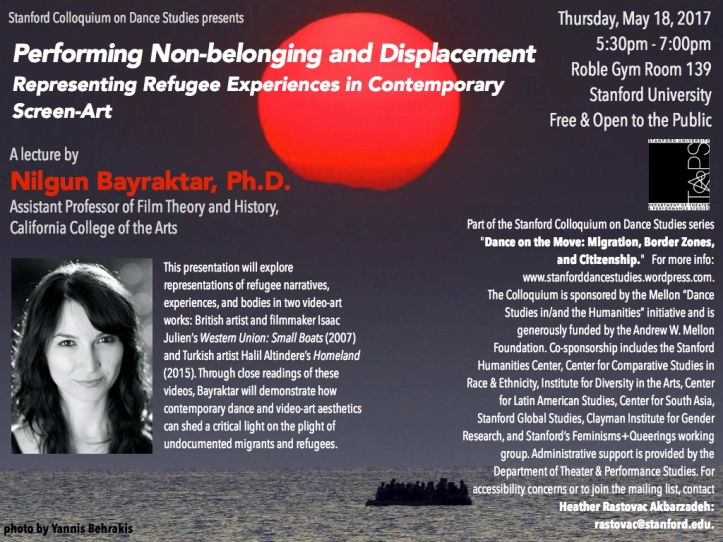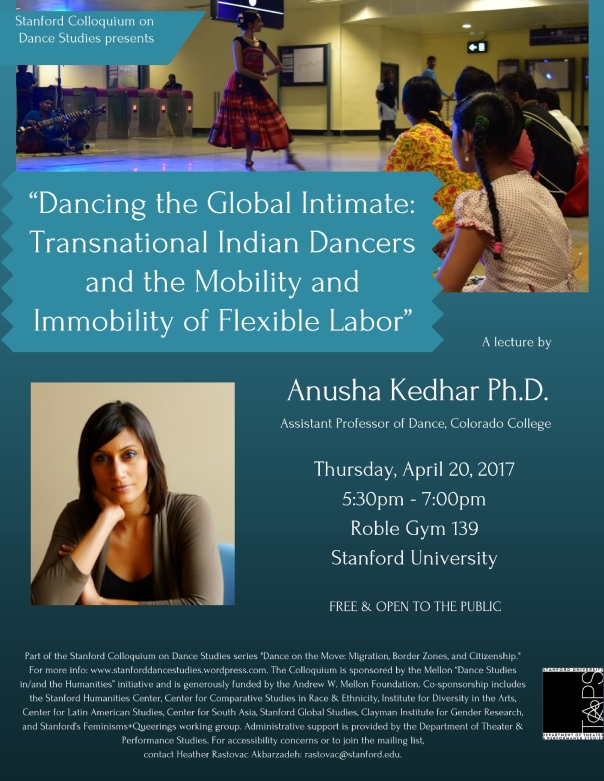The Stanford Colloquium on Dance Studies presents two events featuring
Scholarship on Dance & Dancers in/from Iran
Thurs. May 17, 2018 – A lecture by Dr. Ida Meftahi
Fri. May 18, 2018 – A Roundtable Discussion with Drs. Anthony Shay, Ida Meftahi, and Heather Rastovac Akbarzadeh
Followed by a Performance of Iranian Classical and Contemporary Dances by Aisan Hoss
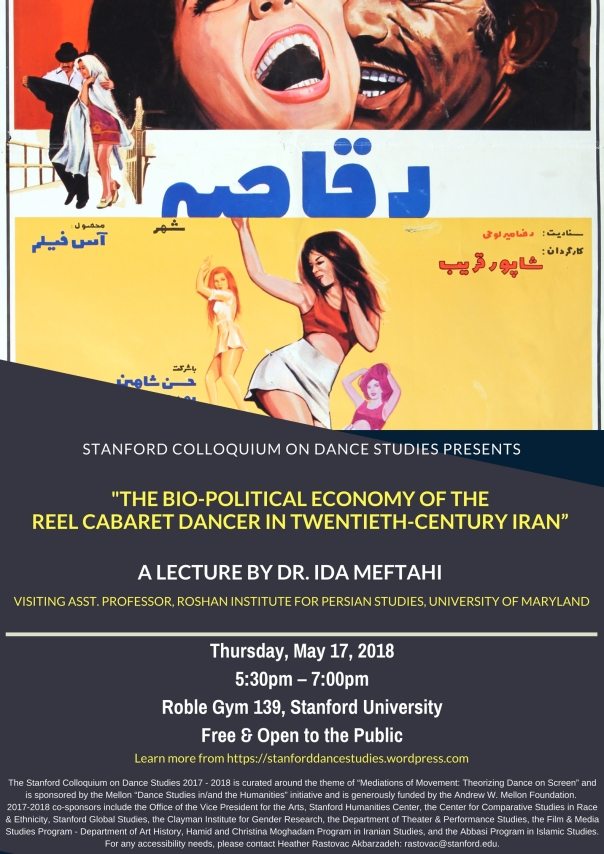
“The Bio-Political Economy of the Reel Cabaret Dancer in Twentieth-Century Iran”
A lecture by Dr. Ida Meftahi (Visiting Assistant Professor of contemporary Iranian culture and society at the Roshan Institute for Persian Studies, University of Maryland)
Discussant: Heather Rastovac Akbarzadeh (Mellon Postdoctoral Fellow in Dance Studies, Stanford)
Thursday, May 17, 2018, 5:30pm – 7:00pm
Roble Gym 139, Stanford University, Free & Open to the Public
Exploring the cabaret scene as well as several inter-connected realms of the popular-culture of Pahlavi-era Iran (1926-1979), this lecture interrogates the cinematic constructions of the cabaret-dancer, a common character-type of the pre-revolutionary commercial cinema, vis-à-vis her social narratives. Drawing from Dr. Meftahi’s historiographical and ethnographic study of dance in Iran, this lecture will examine the emergence of the popular entertainment cabaret scene and its (female) dancing body in light of 20th-century domestic urban transformations and biopolitics, the socio-economics of the popular stage, the formation of cultural and racial categories, and ideological discourses on public performance.
Presenter bio:
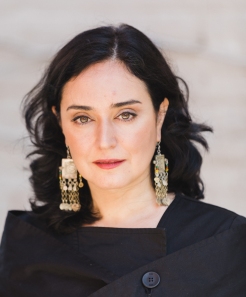 Ida Meftahi is a Visiting Assistant Professor of contemporary Iranian culture and society at the Roshan Institute for Persian Studies, University of Maryland. She completed her doctoral studies at the University of Toronto’s Department of Near and Middle Eastern Civilizations and was a postdoctoral fellow at the Institute for the Arts and Humanities at Pennsylvania State University. Her first book, Gender and Dance in Modern Iran: Biopolitics on Stage was released in Spring 2016 (Routledge Iranian Studies Series). Offering a novel approach to corporeality in twentieth-century Iran, Meftahi’s historiographical analysis encompasses gender, urbanism, performance, cinema, and political economy of public entertainment. Her research has also appeared in Muslim Rap, Halal Soaps, and Revolutionary Theater: Artistic Developments in the Muslim Cultural Sphere (2011), Islam and Popular Arts (2016), Oxford Handbook of Dance and Ethnicity (2016), IranNameh (2016), International Journal of Middle East Studies (2016), and Clio. Femmes, Genre, Histoire (forthcoming, 2017). She is currently working on her second manuscript, a spatial humanities reading of Tehran’s historic entertainment district, while directing the Lalehzar Digital Project, a component of the Roshan Initiative for Digital Humanities.
Ida Meftahi is a Visiting Assistant Professor of contemporary Iranian culture and society at the Roshan Institute for Persian Studies, University of Maryland. She completed her doctoral studies at the University of Toronto’s Department of Near and Middle Eastern Civilizations and was a postdoctoral fellow at the Institute for the Arts and Humanities at Pennsylvania State University. Her first book, Gender and Dance in Modern Iran: Biopolitics on Stage was released in Spring 2016 (Routledge Iranian Studies Series). Offering a novel approach to corporeality in twentieth-century Iran, Meftahi’s historiographical analysis encompasses gender, urbanism, performance, cinema, and political economy of public entertainment. Her research has also appeared in Muslim Rap, Halal Soaps, and Revolutionary Theater: Artistic Developments in the Muslim Cultural Sphere (2011), Islam and Popular Arts (2016), Oxford Handbook of Dance and Ethnicity (2016), IranNameh (2016), International Journal of Middle East Studies (2016), and Clio. Femmes, Genre, Histoire (forthcoming, 2017). She is currently working on her second manuscript, a spatial humanities reading of Tehran’s historic entertainment district, while directing the Lalehzar Digital Project, a component of the Roshan Initiative for Digital Humanities.
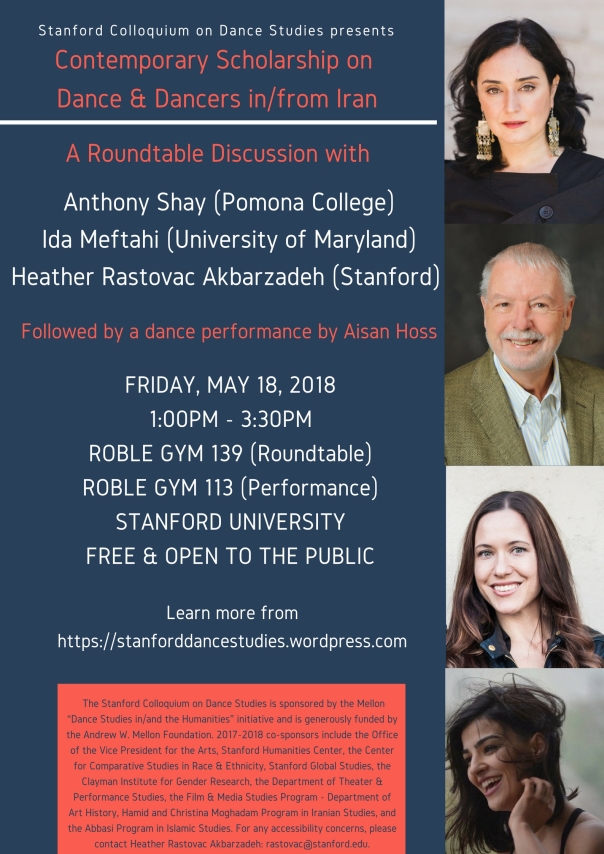
“Contemporary Scholarship on Dance & Dancers in/from Iran”
Roundtable with Drs. Anthony Shay, Ida Meftahi, and Heather Rastovac Akbarzadeh
Followed by a Dance Performance with Aisan Hoss
Friday, May 18, 2018
1:00pm – 3:30pm
Roundtable (1pm – 2:30pm) in Roble Gym 139 + Performance (2:45pm – 3:30pm) in Roble Gym 113, Stanford University
Free & Open to the public
Iranian dance genres and Iranian dancers are gaining increasing attention among scholars and audiences in North America and Europe as Iranian dancers have begun to increasingly circulate among transnational dance circuits and social media over the past ten years. The strict regulation of dance in the Islamic Republic of Iran has also recently gained international media attention with the arrest of Iran’s “Happy Dancers” (seven men and women who produced a YouTube video dancing and lip singing to Pharrell Williams’ pop hit single, “Happy”) and with the American-produced film Desert Dancer (2014), an autobiographical drama that depicts the life of Iranian-born dancer Afshin Ghaffarian. Historically and today, dance in Iran and its diaspora has been a site for the projection and production of a wide range of ideologies and discourses, such as those surrounding: gender and sexuality, modernity, nationalism, religion/secularism, high art/low art, Orientalism and auto-Orientalism, cultural preservation, resistance, neoliberalism, immigration, and citizenship. This roundtable will feature a discussion with three scholars who have contributed to the growing yet understudied field of research on dance and dancers in/from Iran. Dr. Anthony Shay is a preeminent scholar on Iranian dance whose prolific research has been foundational to the field; his 1999 book Choreophobia: Solo Improvised Dance in the Iranian World is the first scholarly monograph on social and staged dance in the Iranian world, and has been invaluable to scholars and dancers alike. Dr. Ida Meftahi’s rigorous historiographical research on dance in 20th and 21st century Iran is also a major contribution to the field, particularly her 2016 monograph Gender and Dance in Modern Iran: Biopolitics on Stage, which draws from a wide range of methodologies and archives to construct the most comprehensive view on dance in Iran to date. Dr. Heather Rastovac Akbarzadeh’s research builds on the work of these two scholars to analyze the politics of dance in the Iranian diaspora, particularly as they relate to the contemporary Euro-American geopolitics of neoliberalism, immigration, and citizenship. Each scholar will give a 15-minute overview of the breadth of their research, which will be followed by a 15-minute discussion between the three of them, and will end with a 30-minute audience Q&A.
*Dr. Anthony Shay will join the panel via Skype.
Following the roundtable, Iranian dancer-choreographer Aisan Hoss will perform as part of this event, followed by an audience Q&A, moderated by Heather Rastovac Akbarzadeh.
Biographies:
 Dr. Anthony Shay serves as Professor of Dance and Cultural Studies in the Theatre and Dance Department of Pomona College in Claremont, CA. He took his Ph.D. at UC Riverside in Dance History and Theory. He is the author of 6 monographs, the editor and co-editor of four anthologies on dance history and aspects of folk and traditional dance, as well as the author of over forty scholarly articles and encyclopedia entries. He was the co-founder, director, and choreographer for the AMAN Folk Ensemble, and founding artistic director of the AVAZ International Dance Theatre. He is one of the recipients of the coveted James Irvine Foundation Choreographic Fellows, an NEH Scholars Fellowship, an NEA Artist in Residence in La Napoule, France, and numerous fellowships for both his scholarly work and his choreographies from the NEA, the Rockefeller Foundation, and the Ahmanson Foundation, among others.
Dr. Anthony Shay serves as Professor of Dance and Cultural Studies in the Theatre and Dance Department of Pomona College in Claremont, CA. He took his Ph.D. at UC Riverside in Dance History and Theory. He is the author of 6 monographs, the editor and co-editor of four anthologies on dance history and aspects of folk and traditional dance, as well as the author of over forty scholarly articles and encyclopedia entries. He was the co-founder, director, and choreographer for the AMAN Folk Ensemble, and founding artistic director of the AVAZ International Dance Theatre. He is one of the recipients of the coveted James Irvine Foundation Choreographic Fellows, an NEH Scholars Fellowship, an NEA Artist in Residence in La Napoule, France, and numerous fellowships for both his scholarly work and his choreographies from the NEA, the Rockefeller Foundation, and the Ahmanson Foundation, among others.
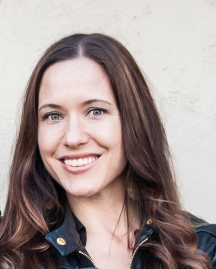 Dr. Heather Rastovac Akbarzadeh is the Mellon Postdoctoral Fellow in Dance Studies in/and the Humanities in the Department of Theater and Performance Studies at Stanford University. She is the curator of the Stanford Colloquium on Dance Studies. She holds a Ph.D. in Performance Studies from UC Berkeley (with a Designated Emphasis in Women, Gender, & Sexuality) and a B.A. in Persian Language & Literature from the University of Washington. Drawing from twenty years as a dancer-choreographer among Iranian-American audiences, Heather’s research investigates the racialized and gendered economies of Iranian dance and performance art in transnational art markets and among diasporic audiences in North America and Western Europe. She is currently working on her first book manuscript about the politics of dance in the Iranian diaspora. Her forthcoming publications include a chapter in the Mellon Dance Studies anthology The Futures of Dance Studies, a chapter in Performing Iran: Cultural Identity and Theatrical Performance, and a commissioned book review in the Journal of Middle East Women’s Studies.
Dr. Heather Rastovac Akbarzadeh is the Mellon Postdoctoral Fellow in Dance Studies in/and the Humanities in the Department of Theater and Performance Studies at Stanford University. She is the curator of the Stanford Colloquium on Dance Studies. She holds a Ph.D. in Performance Studies from UC Berkeley (with a Designated Emphasis in Women, Gender, & Sexuality) and a B.A. in Persian Language & Literature from the University of Washington. Drawing from twenty years as a dancer-choreographer among Iranian-American audiences, Heather’s research investigates the racialized and gendered economies of Iranian dance and performance art in transnational art markets and among diasporic audiences in North America and Western Europe. She is currently working on her first book manuscript about the politics of dance in the Iranian diaspora. Her forthcoming publications include a chapter in the Mellon Dance Studies anthology The Futures of Dance Studies, a chapter in Performing Iran: Cultural Identity and Theatrical Performance, and a commissioned book review in the Journal of Middle East Women’s Studies.
 Aisan Hoss, M.F.A. is a dancer and choreographer from Tehran, Iran. She began studying and performing Iranian dances at the age of twelve and teaching at the age of eighteen. After completing her B.S. in Iran, Hoss moved to London to pursue a career in contemporary dance and attended the Trinity Laban Conservatoire of Contemporary Dance where she completed a one-year diploma in dance, followed by a B.A. in Dance Theatre. She emigrated to the U.S. in 2013 in order to obtain her M.F.A in Dance and Choreography at Mills College in Oakland, California. While at Mills, she received an E.L. Wiegand Foundation Innovator Award. For Hoss, dance and choreography have been a means for gaining insight into her identity as an Iranian living outside of Iran. Specifically, several of her choreographies have explored the ways in which having physical distance from her home country provides a deeper sense of intimacy with Iranian culture. http://www.aisanhossdance.com
Aisan Hoss, M.F.A. is a dancer and choreographer from Tehran, Iran. She began studying and performing Iranian dances at the age of twelve and teaching at the age of eighteen. After completing her B.S. in Iran, Hoss moved to London to pursue a career in contemporary dance and attended the Trinity Laban Conservatoire of Contemporary Dance where she completed a one-year diploma in dance, followed by a B.A. in Dance Theatre. She emigrated to the U.S. in 2013 in order to obtain her M.F.A in Dance and Choreography at Mills College in Oakland, California. While at Mills, she received an E.L. Wiegand Foundation Innovator Award. For Hoss, dance and choreography have been a means for gaining insight into her identity as an Iranian living outside of Iran. Specifically, several of her choreographies have explored the ways in which having physical distance from her home country provides a deeper sense of intimacy with Iranian culture. http://www.aisanhossdance.com
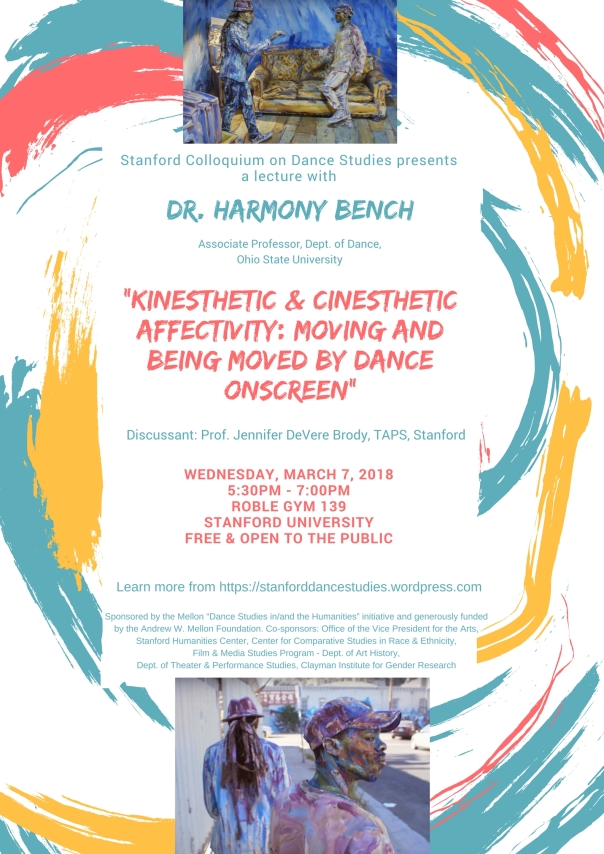
“Kinesthetic and Cinesthetic Affectivity: Moving and Being Moved by Dance Onscreen”
A lecture by Dr. Harmony Bench (Associate Professor of Dance, Ohio State University)
Discussant: Dr. Jennifer DeVere Brody (Professor of Theater & Performance Studies and Chair of CCSRE, Stanford University)
Wednesday, March 7, 2017, 5:30pm – 7:00pm
Roble Gym 139, Stanford University, Free & Open to the Public
In this presentation, I focus on the short video Color of Reality (2016) directed by Jon Boogz with visual art by Alexa Meade and dancing by Boogz and Lil Buck. The video follows a loose narrative structure, addressing anti-black violence without, however, flattening the dancers’ movements to fit a simple storyline or social critique. This presentation is situated in the interdisciplinary field of screendance and pulls from many examples of screendance as well as cinema and media studies, feminist theory, dance studies, and black cultural criticism to articulate the role of kinesthetic (movement of the body) and cinesthetic (movement of the screened image) affectivity in dance onscreen. Pushing against universalizing theories of kinesthetic empathy as well as theories of affect that obscure processes of enculturation, I turn to feminist affect theory and black cultural criticism to articulate a space of danced expressivity and sensuous spectatorship that never loses sight of the fact that bodies are not lived in the abstract. I posit kinesthetic and cinesthetic affectivity within screen-based performance and spectatorship as a way of watching and thinking alongside dance that does not attempt to resolve gaps in understanding, but rather creates a space of ethical encounter across difference.
Presenter bio:
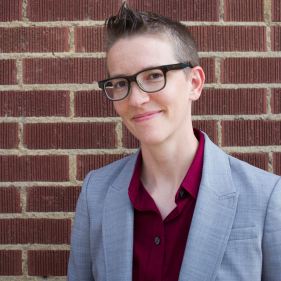 Harmony Bench is Associate Professor in the Department of Dance at The Ohio State University, where she is also affiliated faculty with Theatre, Folklore, Translational Data Analytics, and Women’s, Gender, and Sexuality Studies. Her research sits at the intersections of dance, media, and performance studies and revolves around encounters between bodies and machine or media technologies. Her writing has appeared in the Oxford Handbook of Dance and the Popular Screen, Choreographies of 21st Century War, and Dance on Its Own Terms as well as Theatre Journal, Dance Research Journal, The International Journal of Performance Arts and Digital Media, Participations, and Performance Matters, among others. Current digital humanities projects include: Mapping Touring, which focuses on the performance engagements of early 20th century dance companies, and Dance in Transit, a collaboration with Kate Elswit that considers transportation infrastructure and support networks in Katherine Dunham’s dance touring of the 1950s. Both of these digital works in progress can be found at http://movementonthemove.osu.edu/. Since 2014, she has been co-editor of The International Journal of Screendance with Simon Ellis.
Harmony Bench is Associate Professor in the Department of Dance at The Ohio State University, where she is also affiliated faculty with Theatre, Folklore, Translational Data Analytics, and Women’s, Gender, and Sexuality Studies. Her research sits at the intersections of dance, media, and performance studies and revolves around encounters between bodies and machine or media technologies. Her writing has appeared in the Oxford Handbook of Dance and the Popular Screen, Choreographies of 21st Century War, and Dance on Its Own Terms as well as Theatre Journal, Dance Research Journal, The International Journal of Performance Arts and Digital Media, Participations, and Performance Matters, among others. Current digital humanities projects include: Mapping Touring, which focuses on the performance engagements of early 20th century dance companies, and Dance in Transit, a collaboration with Kate Elswit that considers transportation infrastructure and support networks in Katherine Dunham’s dance touring of the 1950s. Both of these digital works in progress can be found at http://movementonthemove.osu.edu/. Since 2014, she has been co-editor of The International Journal of Screendance with Simon Ellis.
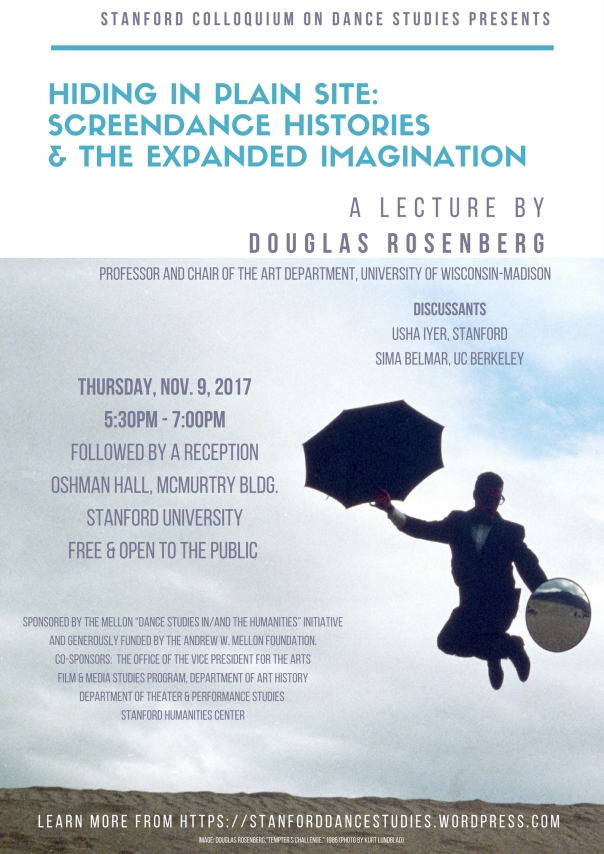
The Third Annual Stanford Colloquium on Dance Studies, 2016-17
Dance on the Move: Migration, Border Zones, and Citizenship
Curated by Heather Rastovac Akbarzadeh, 2016-18 Mellon Postdoctoral Fellow in Dance Studies in/and the Humanities in the Department of Theater & Performance Studies at Stanford University.
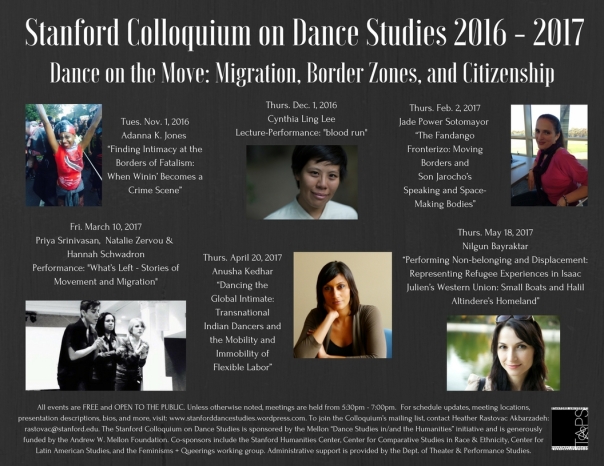
The 2016 – 2017 Colloquium’s engaged interdisciplinary scholars and scholar-practitioners in discussing the ways in which dance performance and practice are sites for examining the mobilities and immobilities that shape and are shaped by various forms of transnational migration and citizenship. We examined how (im)migrant bodies – as subjects constructed through political-economic power relations of race, gender, sexuality, class, nationality, and religion – negotiate, contest, and affirm experiences of belonging/unbelonging in daily life and artistic practice across diverse geographical sites. The rigorous scholarship and performance praxis of the 2016 – 2017 presenters allowed us to assess shared aesthetics between various performances and practices emerging from and within migrant, refugee, and other displaced populations, while critically discerning the historical and situated distinctions between migrant subjects and experiences.
Some of the questions that the 2016 – 2017 Colloquium explored included: How can dance—as theory, method, performance, practice, and an object of analysis—generate critical insight into various forms of migration (voluntary or involuntary) and the subjectivities that emerge from them? What are the limits of dance studies lenses in the study of migration? What conditions of migration, borders, and citizenship produce certain dance forms and certain dancing bodies, historically and today? How do border technologies regulate the movement of bodies and how do dancing bodies intervene in the constructions of borders? What are the affective and material economies within which migrant dancing bodies circulate? How does the study of migration help us think about embodiment, spatiality, temporality, and visuality differently?
The Stanford Colloquium on Dance Studies is sponsored by the Mellon “Dance Studies in/and the Humanities” initiative and is generously funded by the Andrew W. Mellon Foundation. 2016 – 2017 Co-sponsors include the Stanford Humanities Center, Center for Comparative Studies in Race & Ethnicity, Institute for Diversity in the Arts, Center for South Asia, Center for Latin American Studies, Stanford Global Studies, Clayman Center for Gender Research, and the Feminisms+Queerings working group. Administrative support provided by the Department of Theater & Performance Studies.
The Stanford Colloquium on Dance Studies presents:
“Performing Non-belonging and Displacement: Representing Refugee Experiences in Contemporary Screen Art”
A lecture by Dr. Nilgun Bayraktar, Assistant Professor of Film Theory and History, California College of the Arts
With discussant Dr. Usha Iyer, Assistant Professor of Film and Media Studies, Stanford University
Thursday, May 18, 2017
5:30pm – 7:00pm
Roble Gym Room 139
Stanford University
Free & Open to the public
In the final presentation of this year’s Stanford Colloquium on Dance Studies, Dr. Nilgun Bayraktar will explore representations of refugee narratives, experiences, and bodies in two video-art works: British artist and filmmaker Isaac Julien’s Western Union: Small Boats (2007) and Turkish artist Halil Altindere’s Homeland (2015). Through close readings of these videos, Bayraktar will show how contemporary dance and music video aesthetics can shed a critical light on the plight of undocumented migrants and refugees—figures often portrayed in the media and mainstream political discourses as “invaders,” “criminals,” or “victims.”
Julien’s film Western Union, made in collaboration with British choreographer Russell Maliphant, focuses on the perilous journeys of migrants and refugees across the Mediterranean from the North African coast to Lampedusa and Sicily. Integrating the traditions of political documentary filmmaking and modern dance, Western Union examines the multilayered history of post/neo-colonial power relations within the context of contemporary forced im/mobilities. Altindere’s Homeland is a collaboration with Mohammed Abu Hajar, a Syrian rapper now based in Berlin. Abu Hajar’s vibrant rap performance in the video provides rhymes that describe refugee border crossings from Syria to Turkey, then onto Europe. Blurring the boundaries between reality and fiction, Altindere’s images depict the obstacles faced by refugees — barbed wire fences, drones, surveillance cameras, etc.
Presenter Biography:
Nilgun Bayraktar is an assistant professor of Film History, Theory & Criticism in the Visual Studies Program at California College of the Arts. Her work focuses on migrant and diasporic cinema in Europe, transnational cinema, experimental and avant-garde cinema, screen-based art, site-specific art, and performance. She received a B.A. in Cultural Studies from Sabanci University, Istanbul and a Ph.D. in Performance Studies with a designated emphasis in Film & Media Studies from the University of California, Berkeley. Her book, Mobility and Migration in Film and Moving Image Art: Cinema Beyond Europe (Routledge 2016), examines cinematic and artistic representations of migration and mobility in Europe since the 1990s. Bayraktar’s most recent research project explores the intersections between artistic practice and global environmental and social issues such as climate change and mass displacement resulting from neoliberal capitalist practices around the world.
Presentation Description:
Since the beginnings of British South Asian dance in the 1990s, South Asian choreographers have looked to India to fill a gap in the British dance labor market. Drawing on fieldwork in London and Bangalore, this performative lecture examines the intimate lives and experiences of some of these migrant Indian dancers and the way in which they have been mobilized by global political and economic processes. Bodies, however, do not flow as easily as goods and capital. Neoliberal economic ideologies of free trade and the free movement of labor are in tension with anti-immigrant agendas and increasingly narrow notions of British citizenship, particularly since the terrorist attacks in London in 2005. Simultaneously mobilized and blocked, migrant Indian dancers reveal the contradictions of global capitalism as well as the new imaginative practices and new transnational subjectivities that are emerging at these sites of friction. Through dancerly tactics – de-centering, re-routing, stretching – they navigate uncertain economic times and increasingly precarious and temporary work regimes, negotiate personal relationships and family obligations, secure financial independence, and sustain dynamic careers. In doing so, they have found ways to circulate within a racialized and uneven global political economy that seeks to restrict and regulate their movements at every step.
Presenter Biography:
Anusha Kedhar is an Assistant Professor of Dance at Colorado College. Her current book project, titledFlexible Bodies: British South Asian Dancers in an Age of Neoliberal Precarity, examines British South Asian dancers in the late 20th and early 21st century and the creative ways in which these dancers negotiate precarious racial, economic, and national identity positions through flexible bodily tactics. Her scholarly writing has been published by Dance Research Journal, The Feminist Wire, and The New York Times. Kedhar is also an established artist and choreographer, and has worked with various contemporary South Asian choreographers in the US and Europe, including Subathra Subramaniam (London), Mayuri Boonham (London), Mavin Khoo (London/Malta), Johanna Devi (Berlin), Cynthia Ling Lee (Los Angeles), and Meena Murugesan (Los Angeles).
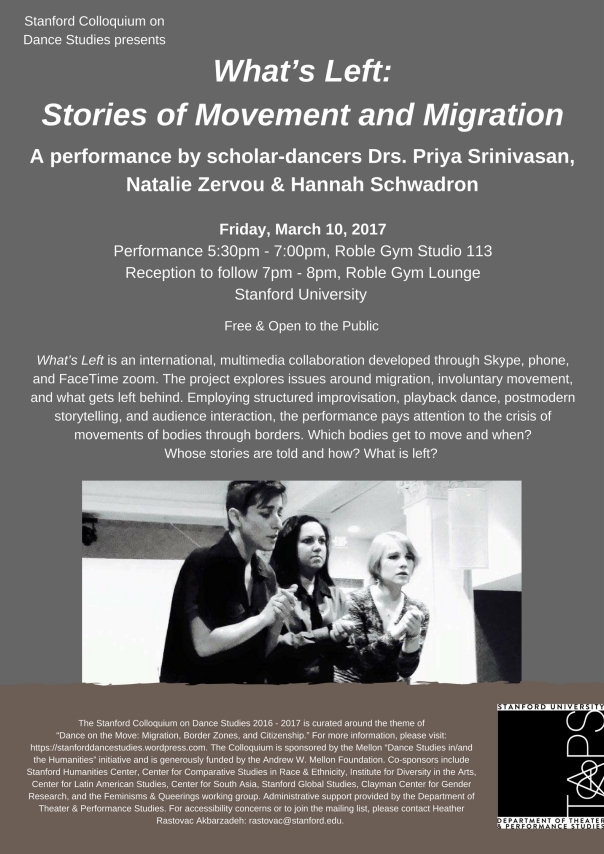
What’s Left – Stories of Movement and Migration
Priya Srinivasan, Ph.D. – Independent Scholar
Natalie Zervou, Ph.D. – Lecturer in Dance, University of Wisconsin, Madison
Hannah Schwadron, Ph.D. – Assistant Professor of Dance History, Florida State University
What’s Left is an international, multimedia collaboration on Skype, phone, and FaceTime zoom to explore the issues around migration, involuntary movement, and what gets left behind in the process. The performance piece involves structured improvisation, playback dance, postmodern storytelling, and audience interaction and involvement in order to pay attention to the crisis of the movement of bodies through borders. Which bodies get to move and when? Whose stories are told and how? What is left? The piece plays with different kinds of time that are imprinted on our bodies: mythological time, historical time, the present and the future. 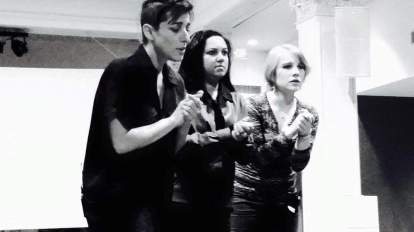
Presenter Biographies:
Priya Srinivasan is a dance scholar and performer who merges dance, immigration law, ethnography, history, critical race theory, performance, and post-colonial studies to investigate the embodied experience of Indian dance. She has lived and performed in Chennai, Melbourne, Los Angeles, Chicago, Shanghai, and more recently in The Hague and Amsterdam. She continues to work as an experimental dance/theatre artist who uses Indian performance practices to understand the effects of migration, history, and power on gendered bodies. She has presented excerpts of her award-winning book Sweating Saris: Indian Dance as Transnational Labor in the hybrid form of “talking dances” at the University of Chicago, University of California, Berkeley, Northwestern University, and Harvard University. She is a Visiting Associate Professor at UC Riverside in Dance, and Fellow at the International Institute of Asian Studies at Leiden University in the Netherlands. Srinivasan has a Ph.D. in Performance Studies from Northwestern University; an M.A. in Dance from UCLA, and a First Class Honors in Ethnomusicology from Monash University. She also received the Gertrude Lippincott Award in 2008, which is given by the Society of Dance History Scholars for the best English-language article published in dance studies.
 Natalie Zervou is a Lecturer at the University of Wisconsin, Madison Dance Department. She holds a Ph.D. in Critical Dance Studies from the University of California, Riverside, an MA in Dance Cultures: Histories and Practices from the University of Surrey (UK), a B.A. in Political Science and International Studies from the University of Athens (Greece), and a Diploma in Dance and Dance Pedagogy from the Higher Professional Dance School Morianova Trasta (Greece). Her research focuses on dance practices during the recent sociopolitical and financial crisis in Greece and explores the ways that performances engage with the current European refugee crisis and respond to the shifting social landscape. Her choreographic work revolves around questions of belonging and migration and has been presented in Athens (Greece), Surrey (UK), Riverside, CA (USA), and Amsterdam (Netherlands). Her publications include: “Bodies of Silence and Resilience: Writing Marginality,” Congress on Research in Dance Conference Proceedings, 2015, pp 174-181 and “Appropriations of Hellenism: A Reconsideration of Early Twentieth-Century American Physical Culture Practices,” CHOROS International Dance Journal, 3 (Spring 2014), pp. 50–68. Zervou also has two forthcoming articles: “Fragments of the European Refugee Crisis: Performing Displacement and the Re-Shaping of Greek Identity” that will be included in an upcoming issue of TDR, and “Rethinking Fragile Landscapes during the Greek Crisis: Precarious Aesthetics and Methodologies in Athenian Dance Performances” that is forthcoming in RiDE (Research in Drama Education) in February 2017. http://www.nataliezervou.com
Natalie Zervou is a Lecturer at the University of Wisconsin, Madison Dance Department. She holds a Ph.D. in Critical Dance Studies from the University of California, Riverside, an MA in Dance Cultures: Histories and Practices from the University of Surrey (UK), a B.A. in Political Science and International Studies from the University of Athens (Greece), and a Diploma in Dance and Dance Pedagogy from the Higher Professional Dance School Morianova Trasta (Greece). Her research focuses on dance practices during the recent sociopolitical and financial crisis in Greece and explores the ways that performances engage with the current European refugee crisis and respond to the shifting social landscape. Her choreographic work revolves around questions of belonging and migration and has been presented in Athens (Greece), Surrey (UK), Riverside, CA (USA), and Amsterdam (Netherlands). Her publications include: “Bodies of Silence and Resilience: Writing Marginality,” Congress on Research in Dance Conference Proceedings, 2015, pp 174-181 and “Appropriations of Hellenism: A Reconsideration of Early Twentieth-Century American Physical Culture Practices,” CHOROS International Dance Journal, 3 (Spring 2014), pp. 50–68. Zervou also has two forthcoming articles: “Fragments of the European Refugee Crisis: Performing Displacement and the Re-Shaping of Greek Identity” that will be included in an upcoming issue of TDR, and “Rethinking Fragile Landscapes during the Greek Crisis: Precarious Aesthetics and Methodologies in Athenian Dance Performances” that is forthcoming in RiDE (Research in Drama Education) in February 2017. http://www.nataliezervou.com
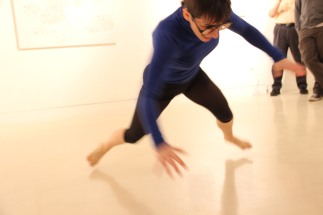 Hannah Schwadron is Assistant Professor of Dance at Florida State University. She holds a Ph.D. in Critical Dance Studies and M.F.A. in Experimental Choreography from the University of California, Riverside. Her research focuses on dance, Jewishness, and gender and she is currently preparing a book for publication, entitled The Case of the Sexy Jewess: Dance, Gender and Jewish Joke-work in US Pop Culture (Oxford University Press, forthcoming). She continues to choreograph and perform on related themes, and has shown work in intimate venues nationally and internationally. She organizes Field Studies, a creative development lab in NYC, that brings together dance artists and scholars to workshop independent and collaborative projects through writing and performance, and extends these intersections into her approach to coursework at the undergraduate and graduate level. http://www.hannahschwadrondance.com
Hannah Schwadron is Assistant Professor of Dance at Florida State University. She holds a Ph.D. in Critical Dance Studies and M.F.A. in Experimental Choreography from the University of California, Riverside. Her research focuses on dance, Jewishness, and gender and she is currently preparing a book for publication, entitled The Case of the Sexy Jewess: Dance, Gender and Jewish Joke-work in US Pop Culture (Oxford University Press, forthcoming). She continues to choreograph and perform on related themes, and has shown work in intimate venues nationally and internationally. She organizes Field Studies, a creative development lab in NYC, that brings together dance artists and scholars to workshop independent and collaborative projects through writing and performance, and extends these intersections into her approach to coursework at the undergraduate and graduate level. http://www.hannahschwadrondance.com
“The Fandango Fronterizo: Moving Borders and Son Jarocho’s Speaking and Space-Making Bodies”
Lecture with Jade Power Sotomayor, Ph.D. – Assistant Professor of Interdisciplinary Arts, Univ. of Washington, Bothell
THURSDAY, FEBRUARY 2, 2017
5:30pm – 7:00pm
Roble Gym Room 139, Stanford University
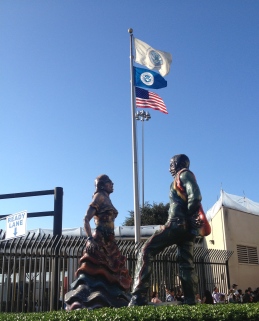 This presentation examines the politics of movement at the Fandango Fronterizo, an annual bi-national son jarocho event that takes place on both sides of the Tijuana/San Isidro border. Dr. Power Sotomayor engages indigenous scholarship on embodied sovereignty to make sense of this embodied music making as a political gesture that challenges and defies the borders imposed by colonial powers. Furthermore, she examines the way that corporeal blackness circulates both as a contestation to the historical erasure of blackness in discourses about Mexico, as well as a valuable signifier of resistance and liberation that, sometimes troublingly so, relies on the construction of black difference and the further bordering of identities.
This presentation examines the politics of movement at the Fandango Fronterizo, an annual bi-national son jarocho event that takes place on both sides of the Tijuana/San Isidro border. Dr. Power Sotomayor engages indigenous scholarship on embodied sovereignty to make sense of this embodied music making as a political gesture that challenges and defies the borders imposed by colonial powers. Furthermore, she examines the way that corporeal blackness circulates both as a contestation to the historical erasure of blackness in discourses about Mexico, as well as a valuable signifier of resistance and liberation that, sometimes troublingly so, relies on the construction of black difference and the further bordering of identities.
Presenter Biography:
 Jade Power Sotomayor is an Assistant Professor in Interdisciplinary Arts at the University of Washington, Bothell. As a code-switching, hyphen-jumping, border-crossing, Cali-Rican educator, dancer, actor and scholar of performance, Dr. Power Sotomayor engages embodied practices of remembering and creating community as a lens for theorizing performative constructions of Latinidad. Her research focuses on epistemologies of the body, the intersections between race, gender and language, and on inter-cultural performance in the Latin Caribbean diaspora. Her book project ¡Habla!: Speaking Bodies in Latinx Dance and Performance examines what she calls the “speaking body” in various sites of performance (solo-performance, Puerto Rican bomba, Mexican son jarocho) and its relationship to the politics of race and ethnicity, to bilingualism and to communities of belonging as constituted through doing versus being. She has recently started research on the experiences of women of color who teach Zumba, and the dancing of a Latinidad that variously cites and appropriates brownness and blackness through complex circuits of embodied signification.
Jade Power Sotomayor is an Assistant Professor in Interdisciplinary Arts at the University of Washington, Bothell. As a code-switching, hyphen-jumping, border-crossing, Cali-Rican educator, dancer, actor and scholar of performance, Dr. Power Sotomayor engages embodied practices of remembering and creating community as a lens for theorizing performative constructions of Latinidad. Her research focuses on epistemologies of the body, the intersections between race, gender and language, and on inter-cultural performance in the Latin Caribbean diaspora. Her book project ¡Habla!: Speaking Bodies in Latinx Dance and Performance examines what she calls the “speaking body” in various sites of performance (solo-performance, Puerto Rican bomba, Mexican son jarocho) and its relationship to the politics of race and ethnicity, to bilingualism and to communities of belonging as constituted through doing versus being. She has recently started research on the experiences of women of color who teach Zumba, and the dancing of a Latinidad that variously cites and appropriates brownness and blackness through complex circuits of embodied signification.
blood run
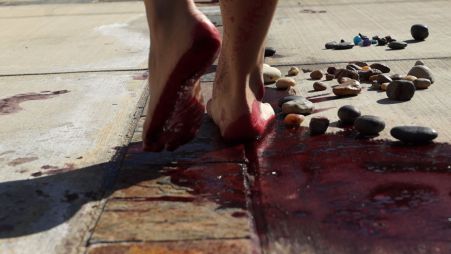
A performance-lecture by Cynthia Ling Lee
Assistant Professor of Dance, UC Santa Cruz
Thursday, December 1, 2016
5:30pm – 7:00pm
Prosser Theater / Memorial Auditorium
Stanford University
Free and open to the public
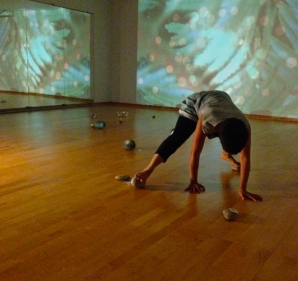 Cynthia Ling Lee will present a lecture-performance on her newest solo show, blood run, a work that asks what hidden histories are contained in the body, while poignantly acknowledging the impossibility of fully reclaiming what has been lost. blood run investigates Lee’s Han Chinese colonizer and Taiwanese plains indigenous heritages within the context of larger political histories, asking: “What is the difference between an immigrant and a colonizer?” “How do the colonizer and colonized live inside the same body?” “When does survival require disappearance?” Combining critical theorization with performing excerpts of the show, Lee will discuss blood run’s development as part of the Post Natyam Collective’s long-distance process, Reimagining Citizenship. She will also address their newest project, Resurfacing Borders, on borders, migration, and citizenship. The Post Natyam Collective is a transnational, web-based coalition of dance artists whose work triangulates between theory, art-making, and activism.
Cynthia Ling Lee will present a lecture-performance on her newest solo show, blood run, a work that asks what hidden histories are contained in the body, while poignantly acknowledging the impossibility of fully reclaiming what has been lost. blood run investigates Lee’s Han Chinese colonizer and Taiwanese plains indigenous heritages within the context of larger political histories, asking: “What is the difference between an immigrant and a colonizer?” “How do the colonizer and colonized live inside the same body?” “When does survival require disappearance?” Combining critical theorization with performing excerpts of the show, Lee will discuss blood run’s development as part of the Post Natyam Collective’s long-distance process, Reimagining Citizenship. She will also address their newest project, Resurfacing Borders, on borders, migration, and citizenship. The Post Natyam Collective is a transnational, web-based coalition of dance artists whose work triangulates between theory, art-making, and activism.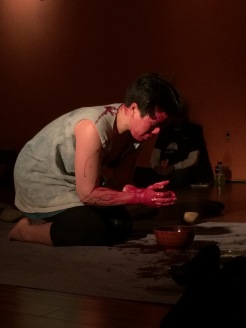
Presenter Biography:
Cynthia Ling Lee creates choreography and scholarship that instigate postcolonial, queer, and feminist-of-color interventions in the field of experimental body-based performance. Trained in US postmodern dance and North Indian classical kathak, she is committed to intimate collaborative processes and foregrounding marginalized voices and aesthetics. Her interdisciplinary performance work has been presented at venues such as Dance Theater Workshop (New York), REDCAT (Los Angeles), East West Players (Los Angeles), Taman Ismail Marzuki (Jakarta), Kuandu Arts Festival (Taipei), IGNITE! Festival of Contemporary Dance (New Delhi), and Chandra-Mandapa: Spaces (Chennai). Cynthia was the recipient of a Thomas J. Watson Fellowship, an Asia-Pacific Performing Arts Exchange Fellowship, and a Taipei Artist Village Residency. 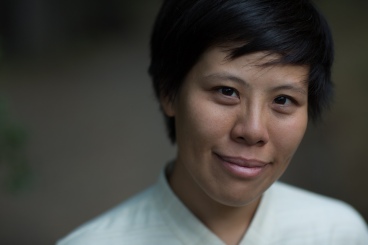 Recent publications include a case study in Dance Education Around the World: Perspectives on Dance, Young People and Change (Routledge) and co-written articles with Sandra Chatterjee in Feminist Media: Participatory Spaces, Networks and Cultural Citizenship (eds. Elke Zobl and Ricarda Drüeke), Studies in South Asian Film and Media, and Meanings and Makings of Queer Dance, ed. Clare Croft (Oxford University Press, anticipated publication date Fall 2017). Influential teachers and mentors include Simone Forti, Eiko & Koma, Judy Mitoma, Pallabi Chakravorty, Bandana Sen, Kumudini Lakhia, Anjani Ambegaokar, and the contact improvisation community. Cynthia is a member of the Post Natyam Collective, a board member of the Network of Ensemble Theaters, and an assistant professor of dance in the Department of Theatre Arts at the University of California at Santa Cruz. www.cynthialinglee.com
Recent publications include a case study in Dance Education Around the World: Perspectives on Dance, Young People and Change (Routledge) and co-written articles with Sandra Chatterjee in Feminist Media: Participatory Spaces, Networks and Cultural Citizenship (eds. Elke Zobl and Ricarda Drüeke), Studies in South Asian Film and Media, and Meanings and Makings of Queer Dance, ed. Clare Croft (Oxford University Press, anticipated publication date Fall 2017). Influential teachers and mentors include Simone Forti, Eiko & Koma, Judy Mitoma, Pallabi Chakravorty, Bandana Sen, Kumudini Lakhia, Anjani Ambegaokar, and the contact improvisation community. Cynthia is a member of the Post Natyam Collective, a board member of the Network of Ensemble Theaters, and an assistant professor of dance in the Department of Theatre Arts at the University of California at Santa Cruz. www.cynthialinglee.com
Excerpts from blood run:
“Finding Intimacy at the Borders of Fatalism:
When Winin’ Becomes a Crime Scene”
Adanna Kai Jones, Ph.D.
Visiting Faculty in Dance, Stanford University
Tuesday, November 1, 2016
5:30pm – 7:00pm
139 Roble Gym, Stanford University

How does the performing pleasure during this year’s (2016) pre-Carnival, J’Ouvert festivities in Brooklyn, NY complicate how we understand anti-black violence and #BlackLivesMatter? The sweaty labor produced by the very act of rolling one’s hips and winin’ dong di streets fuh J’Ouvert reveal the intimately microscopic ways in which winers navigate the colliding politics of pleasure, gun-violence, and state policing. As winers take up public space in a foreign place—namely a place that recognizes or presents their winin’ bodies as in but not of that nation—their rolling production of sweat remain rooted to a bodily logic (i.e. winin’) that reads as fatalistic. Dr. Jones argues that “[…] winin’s association with sexual play leaves especially the female winer vulnerable to depictions of fatalism, nihilism, and ultimate tragedy (e.g., beliefs that skilled female winers are prone to prostitution, out-of-wedlock motherhood, or sexual violence).” In effect, this further positions them within and along the interstices and borders of contesting feelings of blackness, contesting uses of pleasure, as well as contesting performances of (trans)nationhood, or rather a sense of belonging. Ultimately, this talk attends to the unsettling link between violence, pleasure, and blackness, as it is navigated by the dancing body.
About the Presenter:
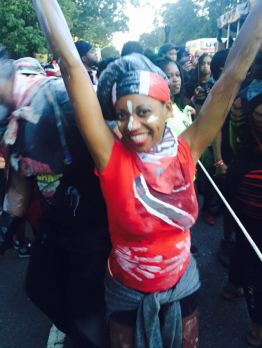
Adanna Kai Jones received her Ph.D. in Critical Dance Studies at the University of California, Riverside, and her BFA in Dance from Mason Gross School of the Arts—Rutgers University. She has performed in professional dance companies based in NYC, including the Julia Ritter Performance Group and Souloworks with Andrea E. Woods. In general, her research remains focused on Caribbean dance and identity politics within the Diaspora, paying particular focus to the rolling hip dance known as winin’. She has published the chapter “Can Rihanna Have Her Cake And Eat It Too?” in The Oxford Handbook of Screendance Studies, which became the point of discussion for a roundtable conversation hosted by the Oxford Comment podcast series. Her upcoming chapter, “A Waist Full of Winin’ Counter-Tails/Tales,” will appear in The Futures of Dance Studies edited volume next year. In her own creative pursuits, she has choreographed dance theater pieces that were not only based on her research but were also used as tools for generating more research questions. In July 2015, she presented “Wine & Tales” in Port of Spain, Trinidad, which was commissioned by New Waves! 2015 and the Dancing While Black Performance Lab. And in May 2016, she presented “Rum & Coke” in New York City at Field Studies 2016. Both performances were rooted in her ethnographic fieldwork on the wine and Caribbean Carnivals within the US. Currently, she is a Lecturer at Stanford University in the Department of Theater and Performance Studies. This quarter, she is teaching two research driven dance courses. One is a survey class on folkloric and popular Afro-Caribbean dances and the other is fusion class that brings together Afro-Caribbean dance techniques with contemporary US-concert dance practices.
If you’d like to get to know Dr. Jones’ work, please feel free to listen to an Oxford U Press podcast featuring Dr. Jones speaking about her chapter in the Oxford Handbook of Screendance Studies. https://soundcloud.com/…/rihanna-episode-39-the-oxf…/s-dzVbL
The Second Annual Stanford Colloquium on Dance Studies, 2015-16
Dance, Racism, and Resistance
Organized by Rachel Carrico, 2015-16 Mellon Postdoctoral Fellow in Dance Studies in/and the Humanities at Stanford
The 2015-16 Stanford Colloquium on Dance Studies featured several scholars and artists addressing the work of dance in constructing race, perpetuating racism, and resisting the status quo.
All events were free and open to the public.
The 2015-16 Stanford Colloquium on Dance Studies was sponsored by the Mellon “Dance Studies in/and the Humanities” initiative and is generously funded by the Andrew W. Mellon Foundation. It received administrative support from Stanford’s Department of Theater and Performance Studies (TAPS), and additional funding from Stanford’s Center for the Comparative Study of Race and Ethnicity.
Monday, May 9
Umi Vaughan, Associate Professor of Africana Studies at California State University, Monterey Bay
Drum Talk, Rebel Dance
- 5:30-7:00 PM
- Memorial Hall, Prosser Studio Theater (2nd Floor)*
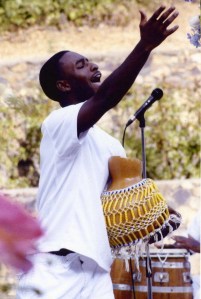 This multimedia performance lecture explores the importance of music and dance in African Diaspora cultures. Dr. Umi Vaughan will use examples from his experience as a researcher, percussionist, and dancer in Oakland, Cuba, Brazil and elsewhere to examine concepts such as improvisation, collective memory/action, redemption/healing, and cultural counter attack in relation to survival and social justice struggle in black communities.
This multimedia performance lecture explores the importance of music and dance in African Diaspora cultures. Dr. Umi Vaughan will use examples from his experience as a researcher, percussionist, and dancer in Oakland, Cuba, Brazil and elsewhere to examine concepts such as improvisation, collective memory/action, redemption/healing, and cultural counter attack in relation to survival and social justice struggle in black communities.
*Note the location change!
For a map of Prosser Studio Theater and nearby free parking options, click here. To map directions on Google maps, click here.
Tuesday, March 29
Anthea Kraut, Associate Professor of Dance and Chair of the Dance Department, University of California, Riverside
Choreographing Copyright
- 5:30-7:00 PM
- Memorial Auditorium 125
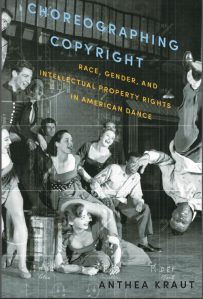 This talk rehearses the major arguments that Kraut makes in her recently published Choreographing Copyright: Race, Gender, and Intellectual Property Rights in American Dance (Oxford University Press, 2016). In the book, Kraut traces the history of efforts to assert copyright protection for choreography in the United States and teases apart their raced and gendered politics. The talk will highlight the stories of some of the major and minor players involved in those efforts. It will also underscore the importance of choreographic copyright for thinking through questions about dance’s reproducibility and for confronting the ways whiteness has functioned as a property-like right in the U.S.
This talk rehearses the major arguments that Kraut makes in her recently published Choreographing Copyright: Race, Gender, and Intellectual Property Rights in American Dance (Oxford University Press, 2016). In the book, Kraut traces the history of efforts to assert copyright protection for choreography in the United States and teases apart their raced and gendered politics. The talk will highlight the stories of some of the major and minor players involved in those efforts. It will also underscore the importance of choreographic copyright for thinking through questions about dance’s reproducibility and for confronting the ways whiteness has functioned as a property-like right in the U.S.
Tuesday, March 1, 2016
Latanya d. Tigner
Choreographer; Coordinator of Dimensions’ Rites of Passage program for youth; and Director, Dimensions Extensions Performance Ensemble
Dimensions Dance Theater: A Legacy of Staged Protest
- 5:30-7:00 PM
- Conference Room: Center for Comparative Studies in Race & Ethnicity; Main Quad, Building 360, Room 361 J/K*

Through video and discussion, Latanya d. Tigner will share Oakland based Dimensions Dance Theater’s legacy of manifesting art emerged from socially and politically charged catalytic events throughout the African Diaspora that have resulted in mass movements to action. Project Panther: Phase I, To March, Common Ground, and the most recent, The Town on Notice, and several other works brought to the stage the struggles, resistance, resilience and hopes of marginalized communities.
*Note the location change!
For a campus map, click here. For directions, click here. There is free parking on Memorial Drive. For a map, please click here.
Tuesday, February 9
Clare Croft
Assistant Professor of Dance, University of Michigan
Centering Race in Dance Research:
Dancers as Diplomats in the Archive and the Interview
- 2:30-4:00 PM
- Memorial Auditorium, Room 125
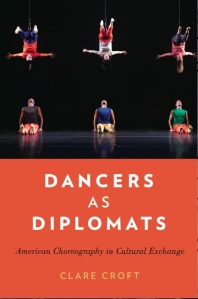 In this talk, dance historian and theorist Clare Croft, author of the recently published Dancers as Diplomats: American Choreography in Cultural Exchange (Oxford 2015), considers how dance research requires a specific attunement to questions of race and racism. How does dance research locate racism among bodies? In the archive? In interviews? Croft considers these questions in relationship to the archival work, performance analysis, and 70+ interviews with dancers that form the spine of Dancers as Diplomats, while also gesturing toward how these questions might guide her new work on dance critic and lesbian activist Jill Johnston.
In this talk, dance historian and theorist Clare Croft, author of the recently published Dancers as Diplomats: American Choreography in Cultural Exchange (Oxford 2015), considers how dance research requires a specific attunement to questions of race and racism. How does dance research locate racism among bodies? In the archive? In interviews? Croft considers these questions in relationship to the archival work, performance analysis, and 70+ interviews with dancers that form the spine of Dancers as Diplomats, while also gesturing toward how these questions might guide her new work on dance critic and lesbian activist Jill Johnston.
Monday, January 25, 2016
Imani Kai Johnson
Assistant Professor of Dance, University of California-Riverside
The Global Cypher? Black Sociality, Soulful Allies, and a Truly Global Culture
- 5:30-7:00 PM
- Memorial Auditorium, Room 125
 In this talk, Dr. Imani Kai Johnson will present excerpted material from her manuscript, Dark Matter in B-Boying Cyphers. Her work explores Africanist aesthetics within b-boying culture, and uses the metaphor of dark matter–the physics concept for invisible matter–to discuss the substantive impact of invisiblized black culture. This talk builds on previously published work on the global context of breaking by examining the stakes of a discourse of globality, and the frictions of working across differences to enact moments of global connection within cyphers.
In this talk, Dr. Imani Kai Johnson will present excerpted material from her manuscript, Dark Matter in B-Boying Cyphers. Her work explores Africanist aesthetics within b-boying culture, and uses the metaphor of dark matter–the physics concept for invisible matter–to discuss the substantive impact of invisiblized black culture. This talk builds on previously published work on the global context of breaking by examining the stakes of a discourse of globality, and the frictions of working across differences to enact moments of global connection within cyphers.
Tuesday, November 10
Rachel Carrico
Mellon Postdoctoral Fellow in Dance Studies in/and the Humanities, Stanford TAPS (2015-16)
Footwork! Bodily Discourses of Dissent at the New Orleans Second Line
- 5:00-6:30 PM
- Memorial Auditorium, Room 125
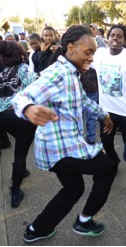
On most Sundays in New Orleans, you can find a second line parade winding through one of the city’s African American neighborhoods. Since the late-nineteenth century, black New Orleanians have staged these grassroots processions, attracting thousands of residents to dance behind a brass band for hours on end. Second liners move their feet in time with complex rhythms, climb atop buildings and leap over one another, all while following the parade’s multi-mile route. In this talk, Carrico will share her research on the second line’s rich dance tradition, proposing that second lining can be productively considered as a bodily discourse of dissent. For citizens who have been historically barred from mainstream discourses, dance can be harnessed as a vehicle for articulating radical worldviews about citizenship, white supremacy, and patriarchy. This talk examines second liners’ dissenting discourses in danced movements and in choreographic uses of the cityscape.
 The Inaugural Stanford Colloquium on Dance Studies, 2014-15
The Inaugural Stanford Colloquium on Dance Studies, 2014-15
Organized by Joanna Dee Das, 2014-15 Mellon Postdoctoral Fellow in Dance Studies in/and the Humanities at Stanford
On October 7, 2014, we had our first colloquium guest: Thomas F. DeFrantz. The event was a great success, and we thank everyone for coming and contributing to a thoughtful, dynamic conversation! More information about the topic of his talk is below.
Choreographing Alienation: Dancing the Museum
This talk explores the phenomenological distancing created by dance performances in the context of 21st-century museums as practiced by hired performers working for celebrity choreographers. The essay considers movement from modern to postmodern, contemporary, relational, and live art articulations of dance practice, and the embodied assumptions that surround each of these chronologically-based namings of dance. The essay considers the ‘high status’ of museum culture and the ‘trading up’ that encourages choreographers to work in the rarefied sites of museums, even as the ethical dimensions of hiring performers to work in these spaces goes under-critiqued. Performances created by Deborah Hay, Tino Seghal, Merce Cunningham company, and Marina Abromovic are considered along axes of race, class, and location.
For Thomas DeFrantz’s biography, please click here.
On November 11, we had Yutian Wong from San Francisco State University present a talk on Shen Yun, which sparked fascinating discussion. Details below!
Shen Yun: An Asian American Dance Company?
Posters for Shen Yun Performing Arts (SYPA) featuring dancers caught mid-leap in impressive displays of balletic virtuosity have become a ubiquitous presence in major cities across the U.S. Using the discourse of Asian American dance studies to think through Shen Yun’s marketing strategies sheds light on the reasons why seemingly overdetermined concepts of authenticity and cultural purity continue to hold such powerful appeal in an era of globalization. The question mark in the title of the paper refers to the way in which SYPA uses both distance and proximity to China, Chinesesness, and the West to establish its authoritative claim to an authentic Chinese culture that is imagined as both ahistorical and pre-communist.
Yutian Wong is the coordinator of the dance program at San Francisco State University. She teaches courses in critical dance studies and writing for dance majors. She is the author of Choreographing Asian America (Wesleyan UP, 2010) and the editor of Contemporary Directions in Asian American Dance Studies (forthcoming).
SanSan Kwan, Assistant Professor in the Department of Theater, Dance, and Performance Studies at University of California, Berkeley started off the Colloquium for the Winter Quarter on February 11 with a fascinating discussion of “love” as a potential framework for understanding intercultural choreography. Below are more details of her talk.
Love Dances: Collaboration in East-West Intercultural Choreography
How do artists collaborate across cultural divides? How do they bring different bodily knowledges to each other and come together to create mutual choreography? What are the ethics and the politics of intercultural engagement? This talk will explore love as a form and a feeling that can structure the sometimes difficult encounter between cultural others. Remembering dance history’s legacy of Orientalism, I will look particularly at a few examples of dance duets between European and Asian or Asian diasporic choreographers (Jérôme Bel and Pichet Klunchun; Emmanuelle Huynh and Akira Kasai; Honji Wang and Sébastien Ramirez). I am interested in the different modes of collaboration they engage, with the hope that love can be a force that shapes cross-cultural commitment.
For SanSan Kwan’s biography, click here.
Jacqueline Shea Murphy, Associate Professor of Dance at the University of California, Riverside, closed the series on May 19. Shea Murphy writes about indigenous dance and rounded out a successful year. More details of her talk appear below.
Dancing in the Here and Now: Indigenous Presence and the Contemporary Choreography of Emily Johnson/Catalyst and DANCING EARTH
This presentation addresses ways that Indigenous choreographers are using contemporary dance in ways that strengthen and assert Indigenous knowledge. Shea Murphy will offer some thoughts about two specific contemporary dance making practices and what they say about time, space, caregiving and taking, disrupted and disputed ways of knowing, visual markers of Native American identity, and being in relationship to each other and the world. She will tease out points of tension around “Indigenous choreography,” including questions about different ways it is and isn’t visible to those viewing; about its strategies of refusal, response-ability, relationality, and “radical decolonial love;” and about the multiplicities, complexities, and possibilities it engages to assert ongoing Indigenous presence and refute the presumptive force and finality of ongoing settler colonization.
For Jacqueline Shea Murphy’s biography, click here.
